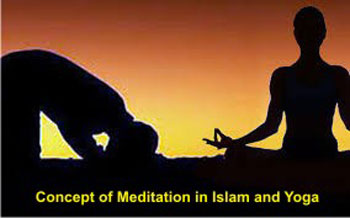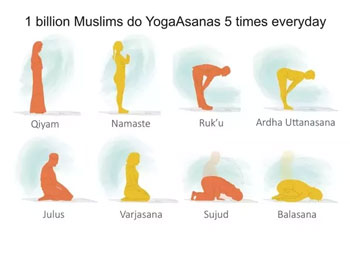Concept of Meditation in Islam and Yoga
Abstract

Yoga is easily found to be integrated with the Islamic life, in fact the two assist one another. Not only is there no conflict, but Islam and yoga together make a mutually beneficial synergy. Both are agreed that, while the body is important as a vehicle on the way to spiritual realization and salvation, the human being's primary identity is not with the body but with the eternal Spirit.This is not a case of syncretism between two religions (which would be spiritually invalid). Yoga is not a religion. Rather, it is a set of techniques and skills that enhance the practice of any religion. Yoga arose from the matrix of the Hindu world, it is of pre-Hindu origin and can be traced back to prehistoric shamanism. Like India's other gifts to world civilization, for example the system of place notation on which all mathematics depends; yoga is not tied to the Hindu religion but has a universal applicability. It helps one to follow one's own religion better whatever that may be. It has certain specific affinities with Islam that make for an interesting study.
Metaphysical doctrine : Since the metaphysic of Advaita Vedanta is in agreement with the tawhid (doctrine of oneness) of Islam, there is perfect compatibility between Islam and yoga on the highest level. All traditional esoterims agree that everything in manifestation has its origin in the Supernal. The manifestations on the material plane are derived from the ideational realm of archetypes (known as al-a 'yan al-thabitah in the metaphysics of Ibn al- Arabi). This world, limited as it is, is just an expression of the ultimate Reality, and will ultimately be reabsorbed in its supernal Origin. Advaita Vedanta and Islamic esoteric metaphysics are agreed that God is the only absolutely real, eternal Reality; all else is contingent and therefore transitory. The unitary view of reality in Advaita Vedanta accords well with the tawhid (divine oneness) of Islam, and the Oneness of Being in the Sufi doctrine of Ibn al-Arabi.It is interesting to compare the symbolism of Prophet Muhammad's nighttime ascent to Heaven, al-Mi'raj, with the corresponding symbolism in yoga. The Prophet ascended on al-Buraq, a riding beast with the head of a woman, through the seven heavens to the Throne of God. In yoga, the kundalini is a feminine power (sakti) that dwells at the base of the spine and ascends through seven levels (represented by the seven cakras to the summit of liberation (brahmarandhra).
Meditation and worship in Islam and Patanjali Yoga.As the second pillar of Islam, Salah is performed by all Muslims across the globe in exactly the same manner and measure, at least the mandatory five prayers. The steps and specific supplications are demonstrated by example by the Holy Prophet Mohammed (PBUH) as mentioned in this Hadith Pray as you have seen me praying and when it is the time for the prayer one of you should pronounce the Adhan and the oldest of you should lead the prayer. (Sahih Bukhari-Book 11: Call to prayers; Hadith 604). In order to realize the far-reaching and deep-seated impact on the attitude, behavior and life of a believer Salah must be understood properly and exercised appropriately as given in the authentic texts.
In part 23 of the Yoga, Sutra, Patanjali teaches the attainment of supreme spiritual realization through devotion to God (isvara pranidhana). The sutra is a very succinct, condensed type of literature, so a single brief mention suffices. Because Patanjali did not elaborate upon it, some commentators have assumed that his God is a mere figurehead or abstraction and therefore not so important in yoga practice. Nothing could be further from the truth; in fact, the one feature that distinguishes the metaphysic of the Yoga darsana from that of the Sankhya darsana of Kapila (a non-theistic analysis of the elements in the cosmos and consciousness) is the presence of God in Yoga. This makes all the difference, and allows the consonance of Yoga with religion.
Patanjali wisely chose to refer to God as isvara, which in Sanskrit simply means 'God, the Supreme Being' and does not name any deity of any particular religion. This universality frees Yoga from conflict with any religious doctrine, so that its techniques can be applied by a believer of any faith. In India, Yoga has been applied to a vast variety of different religious perspectives, and it works just as well for other religions including Islam. There is nothing specifically Hindu or Islamic about its techniques, but it will assist the devotee in any kind of worship. Yoga means to concentrate and still the mind; when this concentration is directed upon God, the yogi is reaching toward the heart of his religion.As for meditation tratakais yogie technique to focus the attention and attain one-pointedness. It consist of fixing the gaze on a single point assist balance, too.) While standing in Islamic prayer we practice trataka by fixing the gaze on a spot on the ground where the forehead rest in sujud.
Ablution -- The purification and preparation OR Sauch It goes without saying that both Islam and yoga require basic physical and moral cleanliness and purify (taharah sauca) before performing their practices.

Salah -- The formal prayer The five mandatory salat are spread over various parts of the day in such a way that the devotee is not only in contact with the Creator frequently and receives peace and blessings as his reward but also experiences physical well-being that has now been scientifically confirmed. [3,7,12]
Yoga derives from the Sanskrit word 'Yuj' which means 'to yoke' , to join the Supreme power ultimately through simple, healthy, sacred and spiritual lifestyles. Thus, yoga implies union and integration of total human being from the inner most to the external nature or the Almighty. It is a path of self-discovery bringing about balance and harmony in life. [14.15] . Physical similarities between Salah and yoga are in the body movements that are repeated in a set pattern. Salah with its five major physical movements finds corresponding movements in yoga called 'asanas'. When performed involving just the physical movement yoga and salah have been found to evoke comparable medical benefits in all major organ systems. While yoga has trainable 'asanas' (but not all 'asanas' rather some of them) than those found in salah, where the latter on the other hand, is more of a spiritual obligatory duty. As mentioned earlier, Islam is a prescription for a complete and balanced way of life, hence, Salah besides being an act of worship doubles as a holistic health tonic.
How to explain the many points of correspondence between yoga and Islam? Did these ancient teachings travel from India to Arabia? No-there is no need to assume such a horizontal transfer; the sacred truths are revealed vertically from Heaven to all people. There are close similarities between Islam and yoga not because of borrowing or cultural diffusion, but because of both originating in the Primordial Tradition, sanatana dharma, al-din al-hanif, which all the prophets of Allah have brought and reaffirmed throughout the ages, among all nations, revealed directly from the Creator.
Associate Professor, G.M.Momin Women's College, University of Mumbai



